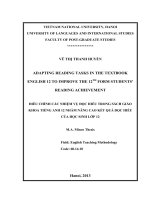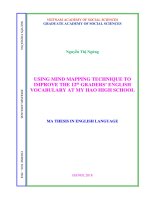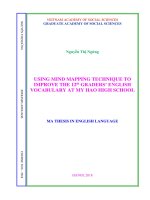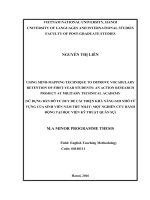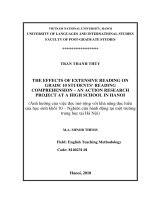Teachers perspectives on applying the mind mapping technique to improve grade 10 students reading comprehension a case study at a high school in dak lak province
Bạn đang xem bản rút gọn của tài liệu. Xem và tải ngay bản đầy đủ của tài liệu tại đây (1.92 MB, 88 trang )
MINISTRY OF EDUCATION AND TRAINING
UNIVERSITY OF QUY NHON
HUYNH THI VAN ANH
TEACHERS' PERSPECTIVES ON APPLYING THE MIND
MAPPING TECHNIQUE TO IMPROVE GRADE 10
STUDENTS' READING COMPREHENSION: A CASE
STUDY AT A HIGH SCHOOL IN DAK LAK PROVINCE
Field: Theory and Methodology English Language Teaching
Code: 8140111
Supervisor: Truong Van Dinh, Ph.D.
Binh Dinh - 2023
BỘ GIÁO DỤC VÀ ĐÀO TẠO
TRƯỜNG ĐẠI HỌC QUY NHƠN
HUỲNH THỊ VÂN ANH
QUAN ĐIỂM CỦA GIÁO VIÊN
VỀ VIỆC ÁP DỤNG SƠ ĐỒ TƯ DUY VÀO CẢI THIỆN KHẢ
NĂNG ĐỌC HIỂU CHO HỌC SINH LỚP 10:
MỘT NGHIÊN CỨU CỤ THỂ TẠI MỘT TRƯỜNG THPT Ở
ĐẮK LẮK
Ngành: Lý luận và phương pháp dạy học bộ môn tiếng Anh
Mã số: 8140111
Người hướng dẫn: TS. TRƯƠNG VĂN ĐỊNH
Bình Định - 2023
i
DECLARATION OF AUTHORSHIP
The thesis entitled “Teachers’ Perspectives on Applying MMT to
improve G10 Students’ Reading Comprehension: A Case Study at a High
School in Dak Lak Province” is conducted under the supervision of Dr.
Truong Van Dinh, a lecturer working at Quy Nhon University.
I declare that the information reported in this study results from my work
and effort, except where due reference is made. The thesis has not been
accepted for any degree and is not simultaneously submitted to any
candidature for any degree or diploma.
Binh Dinh, 2023
Signed
Huynh Thi Van Anh
ii
ACKNOWLEDGEMENTS
Firstly, I would like to express my gratitude to my supervisor, Dr. Truong
Van Dinh, who spent valuable time giving me instructions, advice,
constructive comments and encouragement. This thesis would not have been
completed if it had not been for my supervisor’s great support.
Secondly, I would like to thank my colleagues who encouraged me and
shared much experience in thesis writing with me.
Thirdly, I am also grateful for all the students in my class who
participated in the study, giving me helpful insight into the research problem.
Finally, thanks to all my family support, I completed the thesis on time.
iii
ABSTRACT
This study aims to examine the EFL teachers’ perspectives on using the Mind
Mapping Technique to improve G10 students' reading competency at a high school
in Dak Lak province. To fulfill this aim, the study was carried out with 10 EFL
teachers teaching at Le Duan High School in Dak Lak province. The research
instrument employed in this research included quantitative data questionnaires and
semi-structured interviews for qualitative data. 10 EFL teachers also participated in
the questionnaire and the interviews. The findings showed that most EFL teachers
had positive opinions on the benefits, drawbacks and proposed solutions to
drawbacks of using Mind Mapping Technique to teach reading comprehension to
grade 10 students. The findings also identified that EFL teachers had different
perspectives due to their different teaching experience and knowledge. For further
language teaching and learning, EFL teachers and students at high school level hope
to apply this technique to learning the three other language skills writing, listening
and speaking.
iv
TABLE OF CONTENTS
DECLARATION OF AUTHORSHIP .....................................................................i
ACKNOWLEDGEMENTS..................................................................................... ii
ABSTRACT ............................................................................................................. iii
TABLE OF CONTENTS.........................................................................................iv
LIST OF ABBREVIATIONS................................................................................ vii
LIST OF TABLES ................................................................................................ viii
LIST OF FIGURES ..................................................................................................x
CHAPTER 1. INTRODUCTION ............................................................................1
1.1. Rationale ................................................................................................. 1
1.2. Aim and Objectives of the Study............................................................. 4
1.2.1. Aim of the Study ......................................................................................4
1.2.2. Objectives of the Study ............................................................................4
1.3. Research Questions ................................................................................. 4
1.4. Scope of the Study ................................................................................... 5
1.5. Significance of the Study ......................................................................... 5
1.6. Structure of the Study ............................................................................. 5
CHAPTER 2. LITERATURE REVIEW ................................................................7
2.1. Reading Comprehension ......................................................................... 7
2.1.1. Definition of Reading Comprehension...................................................7
2.1.2. Strategies for Teaching Reading Comprehension .................................9
2.2. Mind Mapping Technique..................................................................... 11
2.2.1. Definition of Mind Mapping Technique ..............................................11
2.2.2. Use of Mind Mapping Technique .........................................................13
2.2.3. Classification of Mind Maps .................................................................15
2.3. EFL Teachers’ Perspectives on Benefits and Drawbacks of Using MMT
to Teach Reading Comprehension........................................................... 19
v
2.3.1. EFL Teachers’ Perspectives on Benefits of Using MMT to Teach
Reading Comprehension .................................................................................19
2.3.2. EFL Teachers’ Perspectives on Drawbacks of Using MMT to Teach
Reading Comprehension .................................................................................20
2.4. Previous Studies .................................................................................... 22
CHAPTER 3. METHODOLOGY .........................................................................26
3.1. Research Design .................................................................................... 26
3.2. Research Setting and Participants ........................................................ 27
3.2.1. Research Setting ....................................................................................27
3.2.2. Participants ............................................................................................27
3.3. Research Instruments ........................................................................... 28
3.3.1. Questionnaire.........................................................................................28
3.3.2. Semi-structured Interview .....................................................................29
3.4. Research Procedures............................................................................. 30
3.4.1. Data Collection ......................................................................................30
3.4.2. Data Analysis .........................................................................................31
3.5. Reliability and Validity ......................................................................... 32
3.5.1. Reliability and Validity of Questionnaire .............................................32
3.5.2. Reliability and Validity of Interview .....................................................33
CHAPTER 4. FINDINGS AND DISCUSSION ...................................................34
4.1. EFL Teachers’ Perspectives on Benefits of Using MMT to Teach
Reading Comprehension ......................................................................... 34
4.2. EFL Teachers’ Perspectives on Drawbacks of Using MMT to Teach
Reading Comprehension........................................................................... 40
4.3. EFL Teachers’ Perspectives on Solutions to Drawbacks of Using MMT to
Teach Reading Comprehension ................................................................ 46
4.4. Summary of the Major Findings........................................................... 54
CHAPTER 5. CONCLUSION AND IMPLICATIONS ......................................56
5.1. Conclusion............................................................................................. 56
5.2. Limitations ............................................................................................ 57
vi
5.3. Pedagogical Implications ...................................................................... 58
5.4. Suggestions for Further Research ......................................................... 59
REFERENCES ........................................................................................................60
APPENDICES .................................................................................................... AP-1
vii
LIST OF ABBREVIATIONS
BA Bachelor of Arts
FELTE Faculty of English Language Teacher Education
FE Faculty of English
UFLS University of Foreign Language Studies
UD University of Danang
L2 Second Language
DL-LDHS Dak Lak-based Le Duan High School
MMT Mind Mapping Technique
EFL English as a Foreign Language
G10 Grade 10
viii
LIST OF TABLES
Table 1 Strategies for Teaching Reading Comprehension 10
Table 2 EFL Tearchers’ Demographic Information 27
Table 3 Reliability of Questionnaire 33
Table 4 Questionnaire of EFL Teachers’ Perspectives on Benefits of MMT 35
Table 5 EFL Teachers’ Views on Use of MMT to Visualize Ideas on Lesson Plans
36
Table 6 EFL Teachers’ Views on Use of MMT to Arouse Students’ Enthusiasm
With Reading Comprehension Lessons 37
Table 7 EFL Teachers’ Views on Use of MMT to Save Time for Revision 38
Table 8 EFL Teachers’ Views on Use of MMT in Vocabulary and Keywords
Memorization 39
Table 9 EFL Teachers’ Views on Use of MMT to Organize Ideas on Topics in a
Systematic Manner 40
Table 10 Questionnaire of EFL Teachers’ Perspectives on Drawbacks of MMT 41
Table 11 EFL Teachers’ Views on Students’ Lack of Necessary Information Due to
Use of MMT 42
Table 12 EFL Teachers’ Views on Use of MMT in Decreasing Students’ Note-
taking Ability 43
Table 13 EFL Teachers’ Views on MMT Leading to a Reduction of Peer Interaction
44
Table 14 EFL Teachers’ Views on U a Waste of Time for Drawing 45
Table 15 EFL Teachers’ Views on Students’ Mind Map Drawing Without Proper
Training 46
Table 16 Questionnaire of EFL Teachers’ Perspectives on Solutions 49
Table 17 EFL Teachers’ Views on Introducing MMT into Curriculum 50
Table 18 EFL Teachers’ Views on Addition of Other Resources to MMT 51
ix
Table 19 EFL Teachers’ Views on Preparation of Mind Maps in Advance 52
Table 20 EFL Teachers’ Views on Awarding Preferential Points for Drawing Mind
Maps 53
Table 21 EFL Teachers’ Views on Saving Time With Online Tools and Software 53
x
LIST OF FIGURES
Figure 1 Example of a Mind Map 12
Figure 2 Rules of Mind Mapping 14
Figure 3 Brace Mind Map 16
Figure 4 Bubble Mind Map 16
Figure 5 Circle Map 17
Figure 6 Tree Mind Map 17
Figure 7 Flow Mind Map 18
Figure 8 Fishbone Mind Map 18
1
CHAPTER 1. INTRODUCTION
This chapter introduces the rationale underlying this current study. The
chapter comprises six parts: (1) rationale, (2) aim and objectives of the study,
(3) research questions, (4) scope of the study, (5) significance of the study and
(6) organization of the study.
1.1. Rationale
At present, English has become an international language used by many
people all over the world. It is taught in most schools, universities and other
educational institutions. It is used as a means of communication among
countries, including in Vietnam, in either spoken or written form. It is also
considered one of the requisite languages in the world and is crucial to learn,
especially for young learners. This language can be used to give or receive
information and advance education, technology and the arts. Moreover, parents
must prepare their children to study English as soon as possible since their brain
is ready for learning and most of them have abilities to memorize well from a
very early time.
There are four primary basic learning skills in English: speaking,
listening, writing and reading. Among them, task is one of the most efficient
ways to get a student's information. Carrell and Grabe (2010) claimed that the
capacity to read in a particular second language (L2) was considered a crucial
skill for academic students; hence, it represented the prime way for
independent language learning.
Reading has played a fundamental role in our lives; it helps students get
information from what they read, which is beneficial in learning English. It
relies on several processes, the most critical of which is reading
comprehension. It is considered the most important mental skill that directly
connects and affects the academic achievement and learning process for a
future career. Therefore, reading comprehension has become a potential field
2
for researchers who study all factors and aspects that may hinder strategies
that might lead to its development.
According to Ningrum and Widyawati (2015), reading is a way to get and
interpret important information and knowledge, involving a complex process
to construct students’ meaning from a written text. In addition,
comprehension in reading can be reached when students know how to apply a
set of skills and strategies to accomplish their reading purposes. Mastering
reading comprehension can help students learn more about documentary
items written in this international language.
Reading comprehension is one of the most essential English aspects that
language learners, including high school students, should master. In Vietnam,
high school students can answer the questions correctly when they can
comprehend the text in the national exam. Yet, some students still find it
challenging to understand the text and so are these at Le Duan High School in
Dak Lak province (DL-LDHS). It is difficult for high school students, such as
tenth-graders, to obtain reading comprehension skills.
Comprehending reading texts is sometimes challenging to achieve. Grade
10 (G10) students at DL-LDHS have low reading comprehension
achievements in reading question types like getting the main idea, supporting
details and even deciding the schematic structure of the text. They need more
than just recalling information given in a text. Mostly, the problems faced are
getting the main idea and the statement stated. Adding to students’ lazy
reading habits, they think reading comprehension is too dull. Consequently,
these students keep making errors and mistakes, especially errors relating to
reading comprehension without unintentionally or intentionally correcting
these errors and mistakes. It is clear that tenth-grade students are weak in
learning English in general and reading comprehension in particular. They
lack suitable strategies that help them comprehend reading texts.
3
These reasons come from both sides, including EFL teachers at DL-
LDHS. On the EFL teachers’ side, they focus mainly on grammar and
vocabulary and pay little attention to students’ reading comprehension
learning strategies. Undeniably, many techniques are engaged in this problem
(such as Vietnamese-English translation, visual illustration by pictures or
short videos, etc.). In particular, EFL teachers also undertake an essential role
in assessing those skills, including reading comprehension, to guarantee the
quality of the learning process via classroom practices or learning activities
that are by far the best support for the students’ learning lessons, supported by
(Rohaniyah & Nasrullah, 2022). Moreover, EFL teachers cannot wholly
transfer their perspectives to students because students and EFL teachers do
not share the same levels of knowledge and experience. Hence, it takes a long
time for students to learn and even a great deal of effort for EFL teachers to
teach these skills.
To deal with these drawbacks, EFL teachers must use more effective
teaching techniques to improve their students’ reading comprehension.
According to several researchers like Siriphanich and Laohawiryanan (2010),
Christodoulou (2019), Liu, Chen and Chang (2010), using MMT to teach
English reading comprehension skills has proven its efficiency in developing
the level of reading competency among students.
Buzan (2007) claims that MMT is a logical and hierarchical thinking
technique that allows EFL teachers to guide students when recording ideas
and information and to combine words with visual representations. Mind
mapping is said to be one of the techniques or activities that can be used in
teaching and learning reading comprehension effectively. Moreover, it is
revealed from his study that MMT has become an appropriate and valuable
teaching technique that improves students’ reading competency since, without
it, students have difficulty understanding texts as well as developing creativity
and imagination to identify the main idea of the passage or the keywords to
answer the questions.
4
As a result, this leads to synthesizing all the information in a newly created
sentence, which becomes the main idea statement from now on. Hence, the
researcher decided to study “Teachers’ perspectives on using mind mapping
technique to improve Grade 10 students’ reading comprehension: A case study at
a high school in Dak Lak province”. The study's findings are hoped to provide a
personal perspective of the researcher and an excellent reference to discuss the use
of MMT in reading comprehension of English language texts. This technique may
indirectly encourage EFL teachers to apply MMT to develop high school students'
low achievement in reading comprehension, thus increasing their academic
results.
1.2. Aim and Objectives of the Study
1.2.1. Aim of the Study
The study aims to examine the EFL teachers’ perspectives on using
MMT to improve students’ levels of reading comprehension at a high school
in Dak Lak province.
1.2.2. Objectives of the Study
To achieve this aim, the researcher tries to fulfill the following
specific objectives:
(1) To explore EFL teachers’ perspectives on the benefits of using MMT
to improve students’ reading comprehension;
(2) To examine EFL teachers’ perspectives on the drawbacks of using
MMT to improve students’ reading comprehension;
(3) To identify solutions proposed by EFL teachers to drawbacks of using
MMT to improve students’ reading comprehension.
1.3. Research Questions
Based on the objectives of this study, the following research questions are
poised to guide the study:
5
1. What are EFL teachers’ perspectives on the benefits of using MMT to
improve students’ reading comprehension?
2. What are EFL teachers’ perspectives on the drawbacks of using MMT to
improve students’ reading comprehension?
3. What solutions do EFL teachers propose to drawbacks of using MMT to
improve students’ reading comprehension?
1.4. Scope of the Study
First, the study cannot cover all aspects of reading comprehension
teaching and learning because of the limited time and resources. The study
focuses only on identifying the EFL teachers’ perspectives on benefits,
drawbacks and solutions for using MMT to improve G10 students’ reading
comprehension in the ‘Tiếng Anh 10 Global Success’ coursebook at Dak Lak-
based Le Duan High School (DL-LDHS). Specially, the study investigates the
EFL teachers’ perspectives on benefits, drawbacks and their proposed solutions
to drawbacks of using MMT to improve at DL-LDHS’s G10 students’ reading
comprehension.
1.5. Significance of the Study
As the study is finished, it is expected to examine the EFL teachers’
perspectives (benefits, drawbacks and their solutions) on using MMT to teach
reading comprehension at DL-LDHS. By reading this study, EFL teachers at
this high school can enrich their techniques in teaching reading
comprehension. Also, curriculum designing will be facilitated by providing
appropriate tasks to assist students in improving English reading
comprehension. Lastly, for researchers of the same interest in teaching
reading comprehension or applying MMT to teaching other language skills,
the study could be a valuable and reliable source for related literature.
1.6. Structure of the Study
The research consists of five chapters:
Chapter 1, Introduction, consists of rationale, aim, objectives, research
questions, scope, significance and organization of the study.
6
Chapter 2, Theoretical Background and Literature Review, briefly
presents the definitions of reading comprehension, MMT, teachers’ benefits,
drawbacks and their solutions to using MMT to teach reading comprehension
and the previous studies on EFL teachers’ perspectives on using MMT to
improve high school students' reading comprehension.
Chapter 3, Methodology, handles Research Design, Research Setting,
Participants, Research Instrument, Procedures of the Study, and Research
Reliability and Validity.
Chapter 4, Findings and Discussion, presents the findings based on the
results of the data analysis.
Chapter 5, Conclusions and Implication, summarizes the conclusions from
the study of the EFL teachers’ perspectives on improving students’ reading
comprehension using MMT.
7
CHAPTER 2. LITERATURE REVIEW
Chapter 2 aims to review the study’s theoretical background of reading
comprehension and Mind Mapping Technique (MMT). This chapter will be
divided into five main sections. It begins with presenting the description of
reading comprehension and strategies to teach reading comprehension. The
following section deals with the definition, use and classification of MMT. EFL
teachers’ benefits and drawbacks of using MMT to teach reading comprehension
are then presented. In this chapter, the researcher also reviews the previous
studies on EFL teachers' perspectives and practices of collaborative reading
comprehension teaching with MMT.
2.1. Reading Comprehension
2.1.1. Definition of Reading Comprehension
Nowadays, English has been taught as a compulsory subject and a part of
the school curriculum in Vietnam. There are four skills that students need to
learn: speaking, listening, writing and reading. Among them, reading
comprehension is considered a language activity to gain information and
knowledge from sources written in the original language. It is a ‘spoken’
interaction between a reader and a writer through a text. According to Spratt,
Pulverness and William (2005), reading is an act that “involves responding to
text, rather than producing it.” In other words, “reading involves making sense
of the text” and then “connects the message of the text to our knowledge of the
world” (p. 21). While reading, students will practice it repeatedly, obtain
information and gain knowledge of what they read and are connected
automatically.
According to Simanjuntak, Simanjuntak and Sihombing's study (2022),
“the human brain has extraordinary abilities in interpreting something that is
seen, felt and read. When a person reads and obtains information, the brain will
create new conclusions based on their knowledge” (p. 32). Therefore, reading
8
has become an exchange activity between the brain and human feelings and
understanding of what is being read. To comprehend a reading text, a person will
release their knowledge to get the meanings of what is read and try to understand
them.
Similarly, Maxom's (2009) and Haerazi, Prayati and Vikasari's study
(2019) shared the same ideas. Reading comprehension is considered “not only
one of the key skills in language learning but also a reinforcement of three
other language skills (speaking, listening and writing)” (p. 139). For high
school students, reading comprehension is an essential method for acquiring
independent ‘knowledge’ from other cultures and countries.
Reading comprehension is considered “the application of a skill that
evolved for other purposes (listening or oral comprehension) to a new form of
input (text)” (Kirby, 2007, p. 1). It depends on two interconnected elements:
word reading (the ability to explain the symbols on the page) and language
comprehension (the ability to understand the meaning of the words and
sentences). When someone reads a text, he/she does not just try to remember
the exact words and phrases they read. Instead, that person forms an
intellectual pattern of the text's details by integrating the words and sentences
into a meaningful message to the reader. Moreover, if the reading activity has
a purpose, the reader will automatically engage with and learn from a text; as
a result, the reader will enjoy what they read and vice versa. Therefore, the
reading comprehension learning process requires continuous practice,
advancement and refinement.
Despite the importance of reading in education and daily life, some
difficulties occur to young learners during the reading learning process, such
as content, vocabulary, learning materials, environment, ineffective teaching
instruction, lack of motivation and so on (Rojas, 2022). Vocabulary and word
knowledge are other factors to facilitate reading comprehension. Reading the
text starts with identifying individual words, for instance, the process that
converts the visual input into linguistic representation. In addition, Lazarus &
Aransiola (2016) also claimed that social-demographic problems, such as
